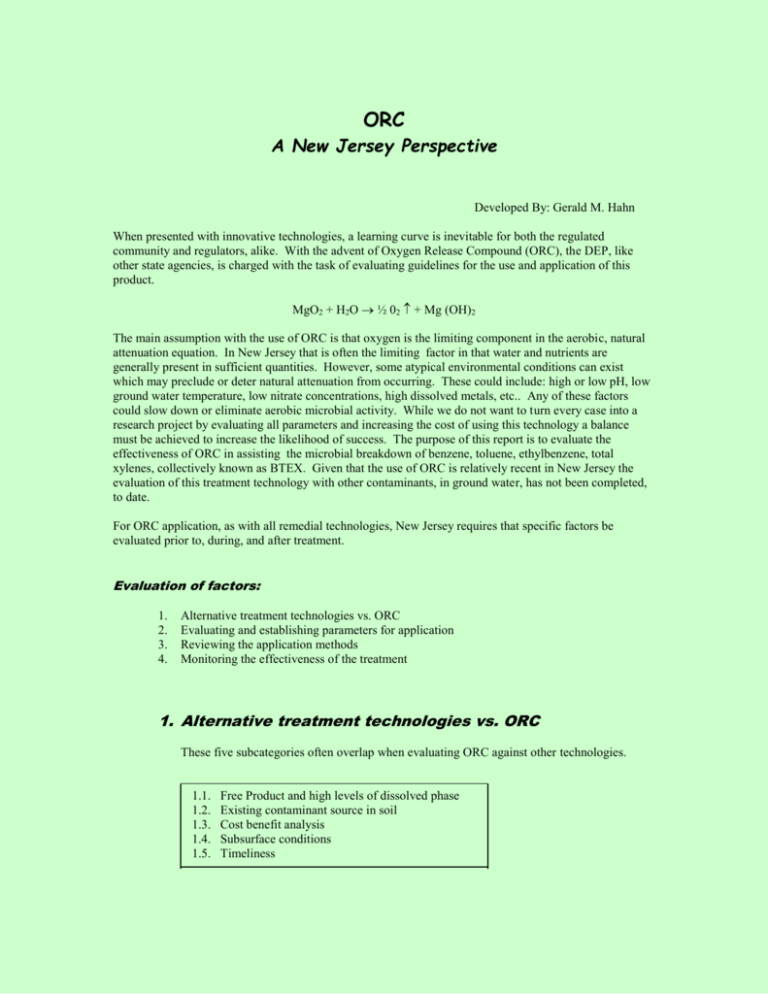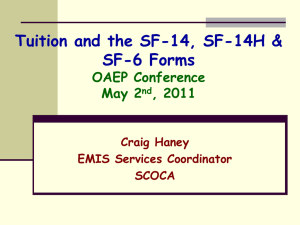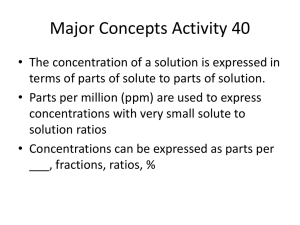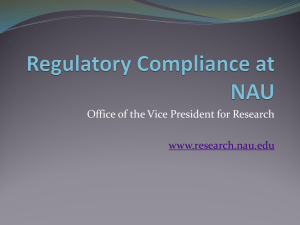ORC - State of New Jersey
advertisement

ORC A New Jersey Perspective Developed By: Gerald M. Hahn When presented with innovative technologies, a learning curve is inevitable for both the regulated community and regulators, alike. With the advent of Oxygen Release Compound (ORC), the DEP, like other state agencies, is charged with the task of evaluating guidelines for the use and application of this product. MgO2 + H2O ½ 02 + Mg (OH)2 The main assumption with the use of ORC is that oxygen is the limiting component in the aerobic, natural attenuation equation. In New Jersey that is often the limiting factor in that water and nutrients are generally present in sufficient quantities. However, some atypical environmental conditions can exist which may preclude or deter natural attenuation from occurring. These could include: high or low pH, low ground water temperature, low nitrate concentrations, high dissolved metals, etc.. Any of these factors could slow down or eliminate aerobic microbial activity. While we do not want to turn every case into a research project by evaluating all parameters and increasing the cost of using this technology a balance must be achieved to increase the likelihood of success. The purpose of this report is to evaluate the effectiveness of ORC in assisting the microbial breakdown of benzene, toluene, ethylbenzene, total xylenes, collectively known as BTEX. Given that the use of ORC is relatively recent in New Jersey the evaluation of this treatment technology with other contaminants, in ground water, has not been completed, to date. For ORC application, as with all remedial technologies, New Jersey requires that specific factors be evaluated prior to, during, and after treatment. Evaluation of factors: 1. 2. 3. 4. Alternative treatment technologies vs. ORC Evaluating and establishing parameters for application Reviewing the application methods Monitoring the effectiveness of the treatment 1. Alternative treatment technologies vs. ORC These five subcategories often overlap when evaluating ORC against other technologies. 1.1. 1.2. 1.3. 1.4. 1.5. Free Product and high levels of dissolved phase Existing contaminant source in soil Cost benefit analysis Subsurface conditions Timeliness ORC - A New Jersey Perspective Page 2 1.1. Free Product and high levels of dissolved phase ORC should not be considered for wells containing free product and should be carefully evaluated when utilized for high dissolved phased contamination. Size of plume and site specific conditions should be evaluated to determine the contaminant mass. This information should be used to determine if ORC or an alternative technology is more appropriate. Reason: Supersaturated contaminant concentrations can be inhibitory to the microbial populations. In addition, if microbial populations are present in these conditions the addition of oxygen generated can be spent too quickly and be cost prohibitive. However, ORC can be considered for use on fringe areas with lower dissolved contaminant concentrations while an alternative treatment addresses more contaminated portions of the site. 1.2. Existing Contaminant Source in Soil ORC has little to no effect on contaminated soils above the capillary fringe. Given that H2O is required to hydrate magnesium peroxide (MgO2) and that ORC is typically applied to contaminants below the static GW table, this compound should not be used exclusively when an existing soil source is present above the ground water table. While ORC may treat the existing ground water contaminant plume, once ORC is spent and not reapplied, the ongoing source can re-contaminate the previously treated aquifer. If the party conducting the remediation can demonstrate that contaminated soils, above the saturated zone, can be eliminated as an ongoing source through an alternative remedial approach, simultaneous use of ORC may be warranted. 1.3. Cost benefit analysis Product loading calculations to determine quantity of ORC necessary for plume treatment can be a quick and inexpensive means of quantifying the cost of this technology when compared with other treatment costs. While this technology may be able to reduce high dissolved phased contaminant levels cost comparisons vs. time, O&M, etc. should be compared with alternative technologies. 1.4. Subsurface conditions ORC should, most likely, not be used for treating contamination in bedrock due to an inefficient means of distributing the product and lack of interconnection between fractures. 1.5. Timeliness ORC may accelerate low concentration natural attenuation cases to unconditional closure. This alternative, like other applications, should be considered when evaluating continued monitoring costs. ORC - A New Jersey Perspective Page 3 2. Evaluating and establishing parameters for application It is necessary to evaluate some or all of the following parameters to determine baseline characteristics of existing GW conditions. Evaluation of the following will aid in determining the proper application of ORC and /or to establish pre-ORC conditions for later effectiveness comparison. 2.1. 2.2. 2.3. 2.4. 2.5. 2.6. 2.7. 2.8. 2.9. 2.10. 2.11. 2.12. 2.13. Contaminant Concentrations Contaminant Types Chemical Oxygen Demand Contaminant Degraders pH Nutrients Dissolved O2 levels Dissolved CO2 levels Ground Water Temperature Iron Magnesium Oxygen Reduction Potential (Redox Potential) Hydraulic Conductivity 2.1. Contaminant Concentrations The size and concentration of the plume must be measured prior to ORC application. 2.2. Contaminant Types While ORC may be used to remediate other contaminants the focus of this evaluation is on BTEX constituents. 2.3. Chemical Oxygen Demand COD is useful in determining the total oxygen demand that organic and inorganic compounds will require once ORC is applied. The COD test is a useful tool to identify oxygen demand “hot spot” (areas which may require “above normal oxygen usage”). A conservative calculation, that Regenesis has provided, converts COD to the Additional Demand Factor (ADF). The ADF, provided by Regenesis, is used in loading calculations required to determine the amount of ORC, the proper application and spacing of application points (as appropriate). Note: Based upon previous remedial efforts an ADF between 8 to 10 is usually required. COD divided by total dissolved VOCs equals the ADF EXAMPLE 150 ppm COD 15 ppm BTEX = 10 ADF 2.4. Contaminant Degraders Measurement of the microbial populations can be used in conjunction with DO and CO 2 analysis. Like DO and CO2, monitoring of specific contaminant degraders can be a useful tool to determine whether ORC has been influential in changing existing biodegradation conditions. Ground Water samples should be collected from the ORC - A New Jersey Perspective Page 4 monitoring well within the highest contaminant levels (if treating the entire plume it would be the source well; if using ORC as a treatment barrier samples should be collected from a well located immediately downgradient of the barrier within the treatment zone). This subject will be discussed in section 4.2, in further detail. 2.5. pH The majority of microbial populations are most active at a neutral pH. This is particularly significant for methanogens. pH RANGES Optimal: pH of 7 Excellent: pH of 6 to 8 Acceptable pH of 5.5 to 9 In addition, an acidic pH range (below 5.5) can accelerate the release of oxygen from the MgO2, supersaturating the surrounding ground water for a brief period, thus rendering the application ineffective. Ground water samples should be collected in one upgradient and one source monitoring well. 2.6. Nutrients Ammonium, nitrates, and/or phosphorous may be limiting factors of microbial activity. Nitrate (NO3-), as oxygen can serve as electron acceptors, so it is important not to add too much and change the balance from aerobic to anoxic to anaerobic depending upon which electron acceptor is most prevalent. When evaluating GW conditions in regional areas with high porosity and low sorptive capabilities (i.e., coarse sands, etc.) it may be necessary to determine whether oxygen is the only limiting factor. 2.7. Dissolved O2 Levels Necessary to establish baseline conditions of both plume and upgradient areas. Minimum acceptable oxygen concentration for natural microbial activity is 0.5 mg/l; however, a higher concentration (2 mg/l is more desirable). Ground water samples should be collected in one upgradient and one source monitoring well. 2.8. Dissolved CO2 Levels Necessary to establish baseline conditions of both plume and upgradient areas. Increases in carbon dioxide levels should indicate increases in microbial activity. Ground water samples should be collected in one upgradient and one source monitoring well. 2.9. Ground Water Temperature Microbial activity is usually optimum between temperatures ranging from 7oC to 17oC, in New Jersey. Cooler ground water temperatures slow metabolic rates of bacteria. For every 10o decrease in temperature a 50% reduction in microbial activity occurs. Higher temperatures promote faster degradation and bacterial expansion. While ground water, at four feet below grade, maintains a constant temperature of 11.7oC (53oF) ground water at zero to four feet may be affected in colder regions of the country during winter months. ORC - A New Jersey Perspective Page 5 The party conducting the investigation should provide ground water temperature readings to help determine if this may be a concern and, if so, wait until spring to apply ORC. 2.10. Iron Iron (like manganese) is inorganic and can create an additional oxygen demand. For every 7 parts of Fe (molecular weight of Fe is 56) it requires one part of O2 (molecular weight of O2 is 8). 2Fe2+ + O2 2FeO Typically when iron is present in ground water, an additional oxygen demand factor of 1 to 2 should be added. There may be upper limits to iron concentrations (=/> 300 ppm) which may preclude the efficient use of ORC. BTEX concentrations must be in higher concentration then iron. Oxygen can precipitate iron out of the aquifer, which could then clog interstitial pore spaces and alter flow patterns (biofowling). Additional study of these parameters will help determine limitations. This test is necessary in areas suspected to have high iron concentrations. If these conditions exist ORC may not be the remedial action of choice. 2.11. Magnesium Since magnesium is a by-product of this process the Department is currently requiring the analysis of this constituent to determine impacts to the surrounding aquifer. . Ground water samples should be collected in one upgradient and one source monitoring well. 2.12. Oxygen Reduction Potential (Redox Potential) If the value of this measurement is greater than -220mV, ORC use should be feasible at the site. For more negative values a more detailed cost analysis should be performed. Samples for this test should be collected at the center of the plume to measure anaerobic conditions. ORC should not be used in these conditions, as quantity of treatment required would make it cost prohibitive. Again, ORC is used to enhance aerobic microbial activity. 2.13. Hydraulic Conductivity Low hydraulic conductivity could significantly reduce the migration of oxygen in the surrounding aquifer. High conductivity can wash the oxygen generated through the surrounding plume too quickly, although, high conductivity may be beneficial when applying ORC in the most passive method (socks). Higher conductivity can aid the flow of ground water around the annular space between the ORC socks and the well and carry the oxygen enriched ground water further downgradient of the well. 3. Reviewing the application methods 3.1. Tank Excavation Backfill Method 3.2. Bore Hole Injection Method 3.3. Bore Hole Backfill Method 3.4. ORC “Socks” one-time application ORC - A New Jersey Perspective Page 6 Note: one-time application = re-digging an excavation or mobilization and use of a Geoprobe on the same site for a second event can add additional costs and labor to the reapplication of ORC using these methods. Reapplication of ORC may be necessary and should be considered in the cost of this technology to reduce contaminant concentrations to acceptable levels. Placing socks in existing monitoring wells is less costly and labor intensive; but at sites with higher contaminant concentrations and larger plumes may have little remedial effect (see below). 3.1. Tank Excavation Backfill Method Applying ORC, below the ground water table, in a tank excavation (source excavation) is a one time application but can cover a large area allowing oxygen enriched ground water to treat the contaminant plume. Note: As with all treatment methods Regenesis provides an ORC Applications software disk (Version 2) which with limited site information can provide application rates. 3.2. Bore Hole Injection Method Injection of a dilute slurry (30% solution) under pressure can treat a wider radius of influence than the ORC bore hole backfill method. This method should not be confused with tank excavation backfill method. Bore hole coverage: Sand - 10 to 20 feet spacing Silt - 5 to 10 feet spacing Clay - 3 to 8 feet spacing 3.3. Bore Hole Backfill Method For clarification purposes, the bore hole backfill method is similar to the bore hole injection method with the exception of the following: Instead of injecting a dilute slurry, under pressure, into the surrounding aquifer the slurry is passively tremied into the bore hole. This method, similar to installing socks in monitoring wells, treats a smaller radius of influence than the injection method. 3.4. ORC “Socks” Socks may be used to supplement injection points or to treat residual contamination to enhance natural remediation efforts. The important factor to remember is that placing a sock in a 4" well typically influences approximately a one to two foot radius ("donut') around the well. The ORC mixture (ORC and sand) initially has a low permeability that hardens into a cement-like material after hydration. The flow of ground water through the treatment wells occurs only in the annular space between the sock and the well casing, and oxygen released from the ORC must diffuse to the exterior of the sock to contact and dissolve into the surrounding ground water. When using this technology to cover an expansive area this would require a greater number of wells at high cost. One advantage “socks” have over one time permanent installation methods is that “socks” can be easily replaced to replenish ORC. The installation of multiple wells can be used for larger long-term projects, to act as an infiltration barrier to prevent further migration of contaminants. The Department requires additional downgradient monitoring wells to monitor the effectiveness of the treatment technology. ORC - A New Jersey Perspective Page 7 4. Monitoring the effectiveness of the treatment 4.1. 4.2. 4.3. 4.4. 4.5. 4.6. Contaminant Concentrations Contaminant Degraders Alkalinity Dissolved Oxygen Levels (O2) Dissolved Carbon Dioxide (CO2) Magnesium 4.1. Contaminant Concentrations One of the main parameters in gauging the effectiveness of the treatment process is to monitor contaminant concentrations in the existing well network. But this is not without its precautions. Since so many variables can influence contaminant concentrations in GW under normal field conditions, one must be careful to evaluate specific factors when determining whether concentration reduction is due to the application of ORC, a change in ground water conditions, or a combination of both. Key point: In order to determine whether a contaminant gradient has been established, a decrease in contaminant levels shall be demonstrated under the full range of hydraulic conditions known to occur at the site. Some factors which can influence a reduction in contaminant GW concentrations: Source removal in conjunction with ORC treatment Change in GW elevation. Evaluating historic and current GW elevations and comparing these values with corresponding contaminant concentrations can aid the evaluator to determine whether GW elevation fluctuations influence post-remedial sampling results. 4.2. Contaminant Degraders Measuring contaminant degraders within 2 to 3 months of ORC application and comparing these concentrations with baseline conditions can provide an indication whether oxygen was the limiting environmental factor. A ground water sample should be collected from a well within or immediately downgradient of the treatment zone. Reviewing hydraulic conductivity, contaminant concentrations, pH, etc., collected within this time frame should provide a reliable snap shot of whether an increase in microbial activity is occurring. Although the majority of the microbial population can be found clinging to soils and a soil sample is the most reliable sampling option in identify indigenous microbial populations, a GW sample can be a cruder yet cost effective tool for gathering adequate information. Additional information will be gathered to determine the efficiency of this analysis. 4.3. Alkalinity Increases in alkalinity may occur during the release of oxygen. ORC - A New Jersey Perspective Page 8 4.4. Dissolved Oxygen Levels (O2) When compared with an upgradient background well, increases in DO levels, in a well located within the treated area, demonstrates that magnesium peroxide is releasing oxygen to the ground water. There are instances when oxygen levels do not increase. This is acceptable only when CO2 concentrations show an increase, bacterial populations increase or contaminant levels continue to decrease. (In addition to field instruments, a titration test is available for measuring this parameter.) This analysis should be conducted from at least one well within the treated plume and one upgradient well. 4.5. Dissolved Carbon Dioxide (CO 2) When compared with an upgradient background well increases in CO2 demonstrate that microbial populations and contaminant breakdown are increasing. A field test can be conducted using a drop count titration test (Hach kit is one available manufacturer). A field meter is also available but may be less accurate. In addition, soil lithology and ground water chemistry may mask actual CO2 concentrations (may not occur due to the presence of cations in the system). 4.6. Magnesium Magnesium can naturally occur in untainted ground water conditions. As previously indicated, magnesium is a by-product of the chemical reaction of ORC. So as dissolved oxygen is released to the surrounding aquifer magnesium concentrations in the surrounding ground water will also increase. The Department has evaluated numerous sites within the state of New Jersey to observe magnesium concentrations as ORC is spent within the aquifer system. Magnesium concentrations were measured in upgradient, source, and downgradient monitoring wells. The review of these cases illustrate that magnesium levels typically elevated within the first three months and by the sixth month (approximately 180 days later) average magnesium concentrations have returned to background conditions. It should be noted that magnesium concentrations collected from the upgradient well fluctuated dramatically during the duration of the pilot studies indicating the varied presence and concentration of this compound in background conditions. Case Studies Problems encountered in evaluating the effectiveness of ORC applications…. Since February 28, 1997 over one hundred NJPDES Permit-by-Rule approvals have been issued for the application of ORC. Of these, ten cases have been evaluated based upon available information and data submitted. Each of these cases represent earlier applications of ORC under Department oversight. As such, site data is limited to the information collected by the responsible party at that time and assumptions must be made regarding the data, in some instances. As you read through the hand out you will discover that unlike controlled bench scale and field studies, site applications must be evaluated under a full range of hydraulic conditions and application methods. The primary concern that we should have in the use of ORC is not only evaluating when a remedial action was effective, but almost as important when it failed. The information provided in the hand out should be used, expanded and applied when deciding whether ORC is applicable for your site. ORC - A New Jersey Perspective Page 9 Evaluating the treatment process Evaluation of existing site conditions, application techniques and monitoring data portray the best available information at that time. Monitoring wells identified within these case studies are all located within overburden material. While results have revealed ORC success stories there were also a few failures. Without having complete data, speculation would conclude that an inadequate quantity of ORC was applied as a result of little or no pre-evaluation of the contaminant plume and surrounding aquifer conditions. In other case evaluations, a few treatment failures could not be explained, again due to inadequate evaluation of site conditions. The provided handout and case studies should illustrate the importance of this point. ORC - A New Jersey Perspective Page 10 REFERENCES Bianchi-Mosquera, G.C., Allen-King, R.M., and Mackay, D.M., Enhanced Degradation of Dissolved Benzene and Toluene Using a Solid Oxygen-Releasing Compound, Ground Water Monitoring and Remediation, Winter 1994, pp 120 – 128 Chapman, S.W., Byerley, B.T., Smyth, J.A., and Mackay, D.M., A Pilot Test of Passive Oxygen Release for Enhancement of In Situ Biormediation of BTEX-Contaminated Ground Water, Ground Water Monitoring and Remediation, Spring 1997, pp 93 – 105 Drever, J.I., The Geochemistry of Natural Water, Second Edition: Prentice Hall, Inc., Engelwood Cliffs, New Jersey. Regenesis Bioremediation Products, ORC ® Applications Software© Version 2.0, San Juan Capistrano, CA. Wiedemeier, T., Wilson, J.T., Kampbell, D.H., Miller, R.N., and Hansen, J.E., Technical Protocol for Implementing Intrinsic Remediation with Long-Term Monitoring for Natural Attenuation of Fuel Contamination Dissolved in Groundwater, Air Force Center for Environmental Excellence Technology Transfer Division, Brooks AFB, San Antonio, Texas, Volume 1 Section 2, pp. 14 –36. ACKNOWLEDGEMENTS Special thanks to Kathy DiGregorio, Jay Basavanhally, Sergio Hönl, Andy Marinucci, and Bill Hose for their assistance and patience in putting it all together. Thanks to those individuals of the Bureau of Underground Storage Tank program who were gracious enough to take time out of their busy schedules to provide pertinent case information.








